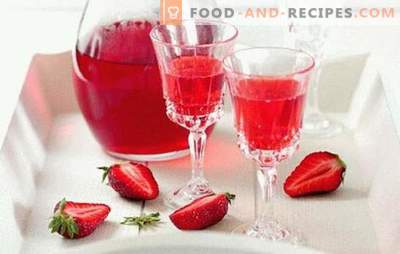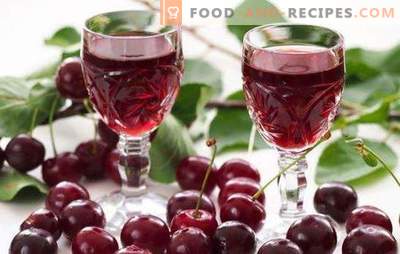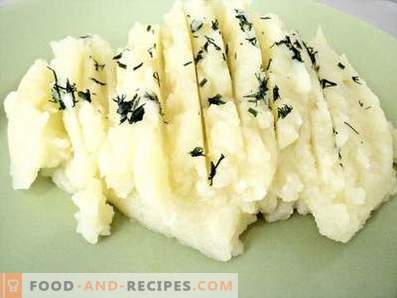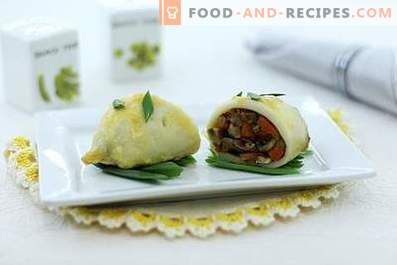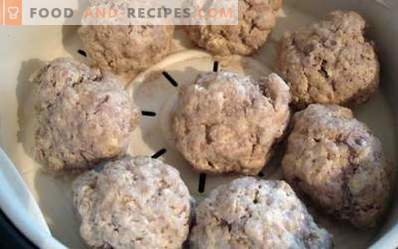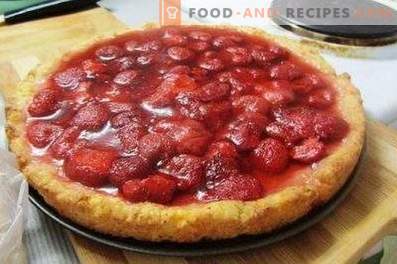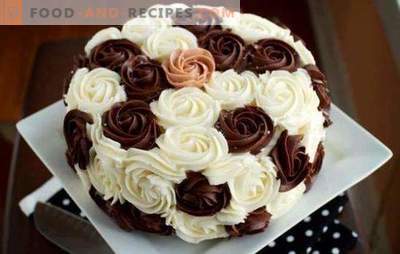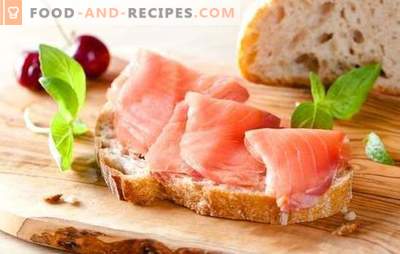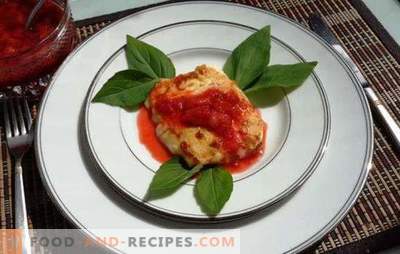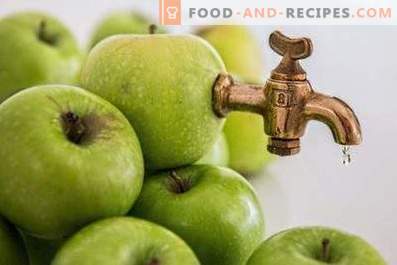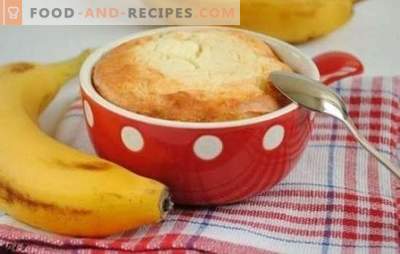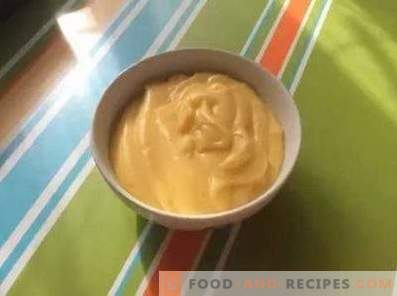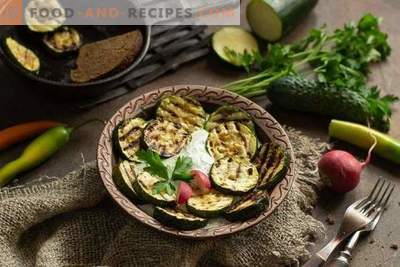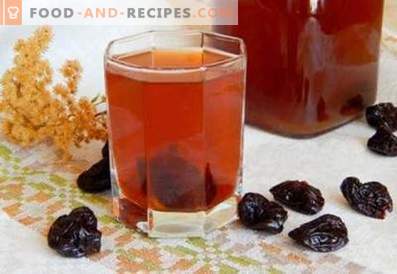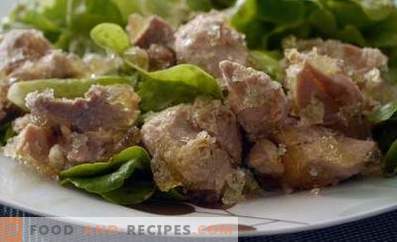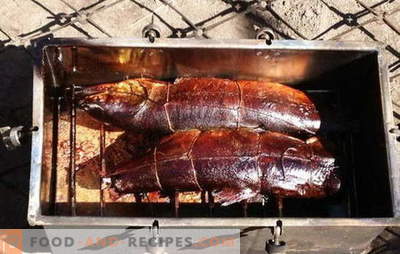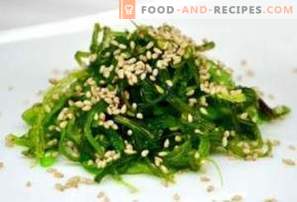
No matter how much they argue about the origin of the cranberry liqueur, which is called “northern lemon“, but the use of this berry is beyond doubt.
And everyone is unanimous in that the cranberry liquefaction at home not only has healing properties with reasonable use, but is also surprisingly light and pleasant to taste.
Homemade cranberry pouring - general cooking principles
Cranberries from those berries, which are said to be sweeter from frost. Therefore, for the preparation of liqueurs, and when used in any recipes, it is better to freeze the berry, even if it is only collected.
There are other undeniable advantages in freezing berries and fruits:
• The separation of juice from the thawed product is more intense than that of fresh fruit.
• You can always get frozen cranberries from the refrigerator, even in early summer, and make a liqueur from it, for example, with cherries, raspberries or strawberries. It is possible, while on vacation, to bring figs or mangoes from the south and combine these exotic fruits with frozen cranberries.
The sour and slightly tart taste of the cranberries blends perfectly with the fruits:
Mango,
Pear,
Apples
Tangerines and oranges,
Other berries.
All sorts of spicy-flavoring additives perfectly complement cranberries:
Cinnamon,
Ginger,
Chocolate,
Carnation
Vanilla,
Mint.
The list of flavors that complement the cranberries can be continued indefinitely. With great confidence we can say that many of the best combinations of flavors and aromas are not yet open.
Fillings belong to the liqueur group of alcoholic beverages. The range of strength, as liqueurs, and liqueurs at the present time - the value of non-permanent. It is believed that liqueurs, stronger drinks than liqueurs. The strength of liqueurs - 12-25%. In your kitchen, you can make a draft of any fortress, if desired. To do this, you can use the alcoholometer or resort to simple arithmetic calculations. The only thing that exactly distinguishes the liqueur from the liqueur is the holding tank. Liqueurs on manufacturing technology should be stored in oak barrels. The pourings are drawn in glass, ceramic or other containers. The exceptions are tanks made of iron or plastic, which are not intended for the storage of food. The basis of the liqueur is fresh, natural juice of fruits or berries. Fruit and berry material for making liqueurs is obtained by crushing raw materials. Depending on the properties of certain fruits, as well as on the recipe, various grinding techniques are used: cutting of fruits, pinching, grinding using mechanical tools (pulp, juice).
For the preparation of the brandy, you can use fruit and berry raw materials of the same type or combine (blend) two or more kinds of fruits.
The resulting fruit mass insist on drinking alcohol, vodka and other beverages containing alcohol, 40% or more: brandy, rum, brandy. The quality of the products listed also affects the taste of the produced liqueurs. It is better to avoid using low grade raw materials containing aldehydes, fusel oils, ethyl alcohol, methanol, and many other hazardous compounds.
Besides the fact that alcohol gives strength to the brandy, it enhances and accelerates the process of separating the juice from the pulp of fruit raw materials.
In the preparation of liqueurs, the method of initial fermentation of the fruit mass is also applied, followed by infusion on alcohol-containing beverages.
The following taste criterion of liqueurs is sugar content. Sugar gives a soft taste of strong liqueur, although in fact it does not reduce the content of alcohol in it. The classic cranberry liqueur according to an industrial recipe contains 30 grams of sugar for every 100 ml of product. At home, this indicator can be varied in accordance with personal preferences.
A great addition to the production of liqueurs are spices and medicinal plants. Using the following recipes you can personally verify this by preparing a cranberry liqueur at home.
Recipe 1. Pouring cranberries at home, with mint
The combination of mint freshness, acidic astringency of red berries and sugar in an alcoholic beverage makes the presence of degrees invisible.
Composition:
• Cranberry juice 2.4 liters
• Honey 400 g
• Mint, fresh (leaves) 250 g
• Sugar (syrup) 850 g
• Alcohol, wine 150-200 ml
Cooking:
Mint tincture is better to prepare in advance, before you start to make the cranberry liqueur. Finely chopped leaves are tightly placed in a jar and poured with alcohol. Closed jar to store deposited away from sunlight. After 2-3 weeks, squeeze the leaves, and clear the resulting tincture using a cotton-gauze filter. Grind cranberries and combine with honey, along with the skin. Hold the resulting mash at a temperature of 20-25 degrees for 10-12 days, shake daily. When fermentation begins, seal with a punctured medical glove. Then we wait for the end of fermentation and remove the cranberry-honey wine from the sediment. Need to wait another week. If sediment reappears, repeat removal. It is better not to filter, but to merge with the help of a straw. In the purified young wine add sugar syrup and mint tincture. We remove the container in a dark place for a couple of months for aging. Now pouring can be tasted. But the real taste and aroma will manifest in about six months. The liqueurs, like the vintage wines, the longer they are aged, the tastier they are.
Recipe 2. Pouring cranberries at home with juniper and kalgan
Raw materials:
• Cranberries, thawed 1 kg
• Juniper, ordinary (berries) 50 g
• Vodka 400 ml
• Sugar 250 g
• Kalgan (Lapchatka) root 20 g
• Water 200 ml
Cooking:
Pour the frozen cranberries into a sieve, under which we place a suitable container for draining water and juice. This liquid is used to make sugar syrup. It contains berry juice and melt water: that is, in essence, it is purified water and juice. If the liquid is not enough, then add to 200 ml of purified water. Syrup is enough to bring to a boil to completely dissolve the sugar. In a gauze bag we tie the root of Kalgan and juniper berries. It is necessary to take into account that only juniper is suitable for food. Juniper berries are sold in specialized stores and pharmacies. It’s better not to buy them on the market if you don’t know what the edible berry should look like. Cranberries slightly crushed to the berries released juice. In the pulp container, lower the healing bag, pour the syrup and vodka, mix the contents of the jar well. Further capacity is removed for storage in a dark and warm place, and “forget” about the bank for a month. After the “discovery” we filter and pour into dark glass bottles.
Recipe 3. Pouring cranberries at home with a citrus scent
Composition:
• Konjak or rum (optional) - 2.1 l
• Oranges - 2.4 kg
• Cranberries, frozen 1.7 kg
• Sugar 0.9 kg-1.0 kg
Cooking:
Cranberry goes well with any citrus. If desired, oranges can be replaced by mandarins. The main thing is that the fruits are sweet enough. The aroma of lemons can also “decorate” the taste of cranberry liqueur, but when using lemon juice you will have to add more sugar. Therefore, if you want to add lemon notes, use only lemon zest or double the sugar content. From 2.2 kg of oranges, you get about a liter of juice. 750 kg of juice comes out of a kilogram of cranberries. So, on average, you should get two liters of pure juice. Now about the fortress. Rum contains 35-40% alcohol, cognac - from 40 to 72%. The strength of the brandy will depend on the selected alcoholic drink and its added volume. The recipe indicates the amount of rum (35%) to produce a liqueur with a strength of 17 - 19%. Bear in mind that the percentage of alcohol should not be below 15 - 16 degrees. This is a critical mark for the functioning of the yeast. Bringing fresh juice to a strength of 15-16 degrees means stopping the fermentation of wild yeast, which will increase the shelf life of liqueur without the risk of undesirable fermentation or souring.
Remove the zest from citrus fruits, peel them and cut into cubes to make juice. Mash wooden pestle cranberries. Combine berries with oranges and pour sugar. Wait for the sugar to dissolve. You can speed up the process: take a small amount of juice or water, pour sugar into it and heat it on the stove until dissolved. All juice is not worth warming up, because vitamin C is destroyed when heated. It is important to preserve vitamins and dizzy aroma in the drink. Next, combine your favorite brandy or rum with syrup and berry-fruit mass, thoroughly shake and tightly close the jar. The filling will be ready in a week. It will need to be thoroughly cleaned from the ground and sediment. A thick alcoholic drink will help a lot when cooking desserts and pastries. Cakes for cakes with such impregnation cause universal delight and surprise.
Recipe 4. Pouring cranberries at home with cognac and pear
The most important tone in the recipe of this liqueur is set not even by cranberries, and not by brandy. In order for homemade cranberry liqueur to have a unique aroma, it is important to choose the variety of the most delicious pear. And pears can create an unforgettable taste. Of course, the champion in flavor - “Duchess”. But, if you can not get this sort of pear, then fit “Carolla”, “Aromatnaya” or “Irista” with a nutmeg smell. If these varieties are not found, you can use any of the most juicy and sweet pears, adding essence with pear flavor.
Composition:
• Pears 3.5 kg
• 1.3 kg frozen cranberries
• Refined sugar 1.7 kg
• Cognac 2.4 L
• Fruit essence (flavoring) “Duchess pearl” 10 mg
Cooking:
Cranberries and sugar will help to get clear and clarified juice from pears. Remove from the pears only seeds and “tails”. Mix the sliced fruit with mashed cranberries. All this should be covered with brandy and mix thoroughly. Over the next two weeks, the contents of the bottle are daily mixed. Under the influence of sugar and brandy juice will come out of the fruit, and the remnants of the pulp will settle on the bottom of the jar. Drain the top of the liquor into separate dishes. Throw the thick through a sieve, previously lined with cotton-gauze filter. Do not wring out. Combine the first and second parts of the tincture, adding a fruit extract if necessary. A month after exposure, check the liqueur. Most likely, you will have to remove the precipitate again. Ready bottling sealed in bottles.
Recipe 5. Pouring cranberries at home with thyme
Composition:
• Cranberry 750 g
• Thyme 50g
• Vodka 250 ml and 100 ml
• Sugar 220 g
Cooking:
Since for a long time thyme (thyme) confidently occupies a leading position in religious rituals, folk medicine, phytotherapy and is always present in everyday life, it would be unfair not to share the recipe for elixir based on cranberry juice and thyme.
Remove the “tails” from the cranberries, sort and pin the berries with a needle, then connect it with thyme and vodka. Bank close and put away in a dark place. To sustain three weeks at room temperature. Drain the resulting tincture and cover the berries with sugar and pour the remaining vodka into them. Shake well and you keep for another three weeks, periodically repeating shaking. Drain the sweet juice and combine it with the tincture obtained as a result of the first drain. Set aside for 3 weeks again. Filling is ready and it can be poured into prepared bottles or decanters.
Recipe 6. Pouring cranberries at home, with mango and chocolate liqueur
For pouring:
• Mango 2 pcs. (800 - 900 g)
• Cranberries 700 g
• Red orange 1 kg
• Wine alcohol 350 ml
• Sugar 2.8 kg
For chocolate liqueur:
• Milk (or cream) 0.25 L
• Sugar 0.3 kg
• Cocoa 100 g
• Vanilla 5 g
• Rum 0,5 l
• Yolks 4 pcs.
Cooking:
Cranberries, mango and oranges
The liqueur and chocolate liqueur is a great duet, although each drink is interesting in itself. Serving them to dessert together or separately is a personal matter.
Let's start with liqueur. Rather, with mango. Ripe mango fruit is very tender and juicy, therefore it is difficult to find fruits ripe under the tropical sun on the shelves of the supermarket. They are brought from India in a semi-ripe stage, green and with firm pulp. But even in this form, mango is an incredibly healthy fruit. More precisely, the berry, whose weight reaches 400 g. To make it easier to get the juice, the mango fruit must first be frozen. We exclude the method of heating immediately so as not to lose valuable vitamins. By the way, the cranberry, too, after defrosting, gives away the juice better and becomes sweeter. Thawed berries, cranberries and mangoes are ground through a sieve. The screen should not be too sieve, so that the mash does not block the holes. Remove the zest from the oranges, separately squeeze the juice from the pulp and send it all into berry puree with half the sugar indicated in the recipe. The resulting wort is left for fermentation, and after a week, when it starts to “play,” seal it against air. Young wine, aged, removed from the sediment is sealed with wine spirit to stop the yeast. From the remaining sugar we prepare a thick syrup: dissolve the sugar (1.4 kg) in 0.5 l of purified water, bring the syrup to a boil. Combine the cooled syrup with wine and ship the bottle for aging, for two months.
Chocolate liqueur
Beat yolks with sugar and vanilla until sugar is completely dissolved. Introduce cocoa into the yolk mass and mix until smooth. In boiling cream or natural milk (homemade), add whipped yolks with continuous stirring. Brewed cream set aside from the heat to cool, adding vanilla. When the cream becomes warm enter rum. Liqueur should make a thick, creamy consistency. Therefore, the amount of added rum is adjusted accordingly.
Recipe 7. Pouring cranberries at home, with bitterness
Composition:
• Spices: ginger, wormwood, anise, hibiscus;
• Cranberries, frozen 2.5 kg
• Raisin 200-300 g
• Water 1.7 L
• Vodka 3 liters
• Sugar 4 kg
Cooking:
Raisin (unwashed) pour warm water (200 ml) and leave warm for about a week for fermentation. Grind the thawed cranberries and add fermented raisins to it, along with liquid and two kilograms of sugar. We put the dishes with the wort into heat and, having waited for it to ferment, pour it into the bottle, closing it with a rubber pierced glove. While we are waiting for the preparation of cranberry wine, we insist on ginger, anise, wormwood and hibiscus (Karkade tea) on vodka. Tincture should be stored for a couple of weeks without access to light. After this, the tincture must be filtered. Ready wine, with no signs of fermentation, defend, remove from sediment by decanting. First, add the tincture to avoid re-fermentation, and then add the rest of the sugar, kneading it until completely dissolved. We maintain the liqueur for 8-10 weeks.
Recipe 8. Cranberry pouring at home, classic
Composition:
• Sugar
• Cranberries
• Vodka (diluted alcohol) 40%
• Water
Cooking:
The ratio of ingredients should be as follows: vodka, sugar and cranberry - 1 part, water - 1/2 part. Mash cranberries slightly. Syrup is prepared from sugar and water. All the ingredients combine in a bowl of suitable volume, close tightly, mix and put in a dark place. Do not forget to shake the can daily for a month. At the end of the aging period, carefully filter the liquor and pour into prepared bottles.
Pouring cranberries at home - tricks and tips
• To filter liqueurs, you should not resort to squeezing the thick through the filter. Be patient, and let the liquid flow arbitrarily: since the liquor will initially be more transparent.
• Ensure that green or rotten fruit is not accidentally caught while making the liqueur. One poor quality berry can ruin all the work.
• As a rule, liquors are stored in dark or opaque glassware. Take care of the storage container in advance. There should also be a question of closure: prepare strong plugs, lids, sealing wax. • Qualitatively prepared liqueurs can be stored for up to three years at room temperature.
It is said that Santa Claus himself invented the cranberry liqueur in his Lapland, and therefore it is considered the New Year and Christmas attribute of the festive table.
If you believe in miracles, then they happen sooner or later. Do not forget to put on the festive table a scarlet-colored pouring from the northernmost berry so that all desires will be fulfilled.



